Bibliometric and Social Network Analysis of Civil Engineering Sustainability Research from 2015 to 2019
Abstract
:1. Introduction
2. Collection of Basic Data and Bibliometric Research of Civil Engineering Sustainability
2.1. Data Collection for Civil Engineering Sustainability Research
2.2. Analysis of Civil Engineering Sustainability Research Based on the Bibliometric
2.2.1. Analysis of the Research Directions of Civil Engineering Sustainability
2.2.2. Analysis of Source Publications of Civil Engineering Sustainability
2.2.3. Analysis of Source Countries and Institutions of Civil Engineering Sustainability
2.3. Establishment of Network Model of Civil Engineering Sustainability Research and Cooperation about Authors Based on Co-Occurrence Frequency
2.3.1. Establishment of Network Model of Civil Engineering Sustainability Research Based on Co-Occurrence Frequency
2.3.2. Establishment of Cooperation Network Model of Civil Engineering Sustainability Based on Authors’ Cooperation
3. Analysis of Civil Engineering Sustainability Research Based on Social Network
3.1. SNA of Civil Engineering Sustainability Research Network
3.1.1. Whole Network Analysis of Civil Engineering Sustainability Research Network
3.1.2. Centrality Analysis of Civil Engineering Sustainability Research Network
3.2. SNA of Cooperation Network
3.2.1. Degree Centrality of Cooperation Network
3.2.2. Betweenness Centrality of Cooperation Network
4. Discussion
5. Conclusions and Outlooks
Author Contributions
Funding
Conflicts of Interest
References
- Liu, B.; Wu, J.; Zhang, J.; Wang, L.; Yang, J.; Liang, D.; Dai, Q.; Bi, X.; Feng, Y.; Zhang, Y.; et al. Characterization and source apportionment of PM2.5 based on error estimation from EPA PMF 5.0 model at a medium city in China. Environ. Pollut. 2017, 222, 10–22. [Google Scholar] [CrossRef]
- Kurda, R.; Silvestre, J.; De Brito, J. Life cycle assessment of concrete made with high volume of recycled concrete aggregates and fly ash. Resour. Conserv. Recycl. 2018, 139, 407–417. [Google Scholar] [CrossRef]
- Chau, C.-K.; Leung, T.; Ng, W. A review on life cycle assessment, life cycle energy assessment and life cycle carbon emissions assessment on buildings. Appl. Energy 2015, 143, 395–413. [Google Scholar] [CrossRef]
- Jensen, J.S. Innovative and sustainable operation and maintenance of bridges. Struct. Infrastruct. Eng. 2020, 16, 1–12. [Google Scholar] [CrossRef]
- Han, J.; Thakur, J.K. Sustainable roadway construction using recycled aggregates with geosynthetics. Sustain. Cities Soc. 2015, 14, 342–350. [Google Scholar] [CrossRef]
- Govindan, K.; Shankar, K.M.; Kannan, D. Sustainable material selection for construction industry-a hybrid multi criteria decision making approach. Renew. Sustain. Energy Rev. 2016, 55, 1274–1288. [Google Scholar] [CrossRef]
- Zhang, Y.; Wang, J.; Hu, F.; Wang, Y. Comparison of evaluation standards for green building in China, Britain, United States. Renew. Sustain. Energy Rev. 2017, 68, 262–271. [Google Scholar] [CrossRef]
- Finnegan, S.; Jones, C.; Sharples, S. The embodied CO2e of sustainable energy technologies used in buildings: A review article. Energy Build. 2018, 181, 50–61. [Google Scholar] [CrossRef]
- Chenari, B.; Carrilho, J.D.; da Silva, M.G. Towards sustainable, energy-efficient and healthy ventilation strategies in buildings: A review. Renew. Sustain. Energy Rev. 2016, 59, 1426–1447. [Google Scholar] [CrossRef]
- Dong, Y.H.; Ng, S.T. A life cycle assessment model for evaluating the environmental impacts of building construction in Hong Kong. Build. Environ. 2015, 89, 183–191. [Google Scholar] [CrossRef]
- Chou, J.S.; Yeh, K.C. Life cycle carbon dioxide emissions simulation and environmental cost analysis for building construction. J. Clean. Prod. 2015, 101, 137–147. [Google Scholar] [CrossRef]
- Dong, Y.H.; Ng, S.T. A social life cycle assessment model for building construction in Hong Kong. Int. J. Life Cycle Assess. 2015, 20, 1166–1180. [Google Scholar] [CrossRef]
- Wang, J.; Tingley, D.D.; Mayfield, M.; Wang, Y. Life cycle impact comparison of different concrete floor slabs considering uncertainty and sensitivity analysis. J. Clean. Prod. 2018, 189, 374–385. [Google Scholar] [CrossRef]
- Holloway, S.; Parrish, K. The contractor’s role in the sustainable construction industry. Proc. Inst. Civ. Eng. Eng. Sustain. 2015, 168, 53–60. [Google Scholar] [CrossRef]
- Liu, S.; Qian, S. Evaluation of social life-cycle performance of buildings: Theoretical framework and impact assessment approach. J. Clean. Prod. 2019, 213, 792–807. [Google Scholar] [CrossRef]
- Jin, R.; Chen, Q.; Soboyejo, A. Survey of the current status of sustainable concrete production in the US. Resour. Conserv. Recycl. 2015, 105, 148–159. [Google Scholar] [CrossRef]
- Xuan, D.; Poon, C.S.; Zheng, W. Management and sustainable utilization of processing wastes from ready-mixed concrete plants in construction: A review. Resour. Conserv. Recycl. 2018, 136, 238–247. [Google Scholar] [CrossRef]
- Chiang, Y.H.; Li, V.J.; Zhou, L.; Wong, F.K.; Lam, P.T. The nexus among employment opportunities, life-cycle costs, and carbon emissions: A case study of sustainable building maintenance in Hong Kong. J. Clean. Prod. 2015, 109, 326–335. [Google Scholar] [CrossRef]
- Vilches, A.; Garcia-Martinez, A.; Sanchez-Montanes, B. Life cycle assessment (LCA) of building refurbishment: A literature review. Energy Build. 2017, 135, 286–301. [Google Scholar] [CrossRef]
- Dong, Y.H.; Ng, S.T. A modeling framework to evaluate sustainability of building construction based on LCSA. Int. J. Life Cycle Assess. 2016, 21, 555–568. [Google Scholar] [CrossRef]
- Díaz-López, C.; Carpio, M.; Martín-Morales, M.; Zamorano, M.A. A comparative analysis of sustainable building assessment methods. Sustain. Cities Soc. 2019, 49, 101611. [Google Scholar] [CrossRef]
- Almeida, C.P.; Ramos, A.F.; Silva, J.M. Sustainability assessment of building rehabilitation actions in old urban centres. Sustain. Cities Soc. 2018, 36, 378–385. [Google Scholar] [CrossRef]
- Mahmoud, S.; Zayed, T.; Fahmy, M. Development of sustainability assessment tool for existing buildings. Sustain. Cities Soc. 2019, 44, 99–119. [Google Scholar] [CrossRef]
- Shekhar, S.; Ghosh, J.; Padgett, J.E. Seismic life-cycle cost analysis of ageing highway bridges under chloride exposure conditions: Modelling and recommendations. Struct. Infrastruct. Eng. 2018, 14, 941–966. [Google Scholar] [CrossRef]
- O’Born, R. Life cycle assessment of large scale timber bridges: A case study from the world’s longest timber bridge design in Norway. Transp. Res. Part D Transp. Eng. 2018, 59, 301–312. [Google Scholar] [CrossRef]
- Navarro, I.J.; Yepes, V.; Marti, J.V. Social life cycle assessment of concrete bridge decks exposed to aggressive environments. Environ. Impact Assess. Rev. 2018, 72, 50–63. [Google Scholar] [CrossRef]
- Du, G.; Pettersson, L.; Karoumi, R. Soil-steel composite bridge: An alternative design solution for short spans considering LCA. J. Clean. Prod. 2018, 189, 647–661. [Google Scholar] [CrossRef]
- Pang, B.; Yang, P.; Wang, Y.; Kendall, A.; Xie, H.; Zhang, Y. Life cycle environmental impact assessment of a bridge with different strengthening schemes. Int. J. Life Cycle Assess. 2015, 20, 1300–1311. [Google Scholar] [CrossRef]
- Zhang, Y.R.; Wu, W.J.; Wang, Y.F. Bridge life cycle assessment with data uncertainty. Int. J. Life Cycle Assess. 2016, 21, 569–576. [Google Scholar] [CrossRef]
- Arya, C.; Amiri, A.; Vassie, P. A new method for evaluating the sustainability of bridges. Proc. Inst. Civ. Eng. Struct. Build. 2015, 168, 441–453. [Google Scholar] [CrossRef]
- Yadollahi, M.; Ansari, R.; Abd Majid, M.Z.; Yih, C.H. A multi-criteria analysis for bridge sustainability assessment: A case study of Penang Second Bridge, Malaysia. Struct. Infrastruct. Eng. 2015, 11, 638–654. [Google Scholar] [CrossRef]
- Balaguera, A.; Carvajal, G.I.; Albertí, J.; Fullana-I-Palmer, P. Life cycle assessment of road construction alternative materials: A literature review. Resour. Conserv. Recycl. 2018, 132, 37–48. [Google Scholar] [CrossRef]
- Chiu, C.T.; Hsu, T.H.; Yang, W.F. Life cycle assessment on using recycled materials for rehabilitating asphalt pavements. Resour. Conserv. Recycl. 2008, 52, 545–556. [Google Scholar] [CrossRef]
- Ferreira, V.J.; Vilaplana, A.S.D.G.; García-Armingol, T.; Aranda-Usón, A.; Lausín-González, C.; López-Sabirón, A.M.; Ferreira, G. Evaluation of the steel slag incorporation as coarse aggregate for road construction: Technical requirements and environmental impact assessment. J. Clean. Prod. 2016, 130, 175–186. [Google Scholar] [CrossRef]
- Aurangzeb, Q.; Al-Qadi, I.L.; Ozer, H.; Yang, R. Hybrid life cycle assessment for asphalt mixtures with high RAP content. Resour. Conserv. Recycl. 2014, 83, 77–86. [Google Scholar] [CrossRef]
- Martinho, F.; Picado-Santos, L.; Capitão, S. Feasibility assessment of the use of recycled aggregates for asphalt mixtures. Sustainability 2018, 10, 1737. [Google Scholar] [CrossRef] [Green Version]
- Soroushian, P.; Ghebrab, T. Field investigation of high-volume fly ash pavement concrete. Resour. Conserv. Recycl. 2013, 73, 78–85. [Google Scholar]
- Xu, G.; Shi, X. Characteristics and applications of fly ash as a sustainable construction material: A state-of-the-art review. Resour. Conserv. Recycl. 2018, 136, 95–109. [Google Scholar] [CrossRef]
- Hemalatha, T.; Ramaswamy, A. A review on fly ash characteristics–towards promoting high volume utilization in developing sustainable concrete. J. Clean. Prod. 2017, 147, 546–559. [Google Scholar] [CrossRef]
- Wang, J.; Wang, Y.; Sun, Y.; Tingley, D.D.; Zhang, Y. Life cycle sustainability assessment of fly ash concrete structures. Renew. Sustain. Energy Rev. 2017, 80, 1162–1174. [Google Scholar] [CrossRef]
- Zhang, Y.; Zhang, J.; Lü, M.; Wang, J.; Gao, Y. Considering uncertainty in life-cycle carbon dioxide emissions of fly ash concrete. Proc. Inst. Civ. Eng. Eng. Sustain. 2019, 172, 198–206. [Google Scholar] [CrossRef]
- Dimitriou, G.; Savva, P.; Petrou, M.F. Enhancing mechanical and durability properties of recycled aggregate concrete. Constr. Build. Mater. 2018, 158, 228–235. [Google Scholar] [CrossRef]
- Guo, H.; Shi, C.; Guan, X.; Zhu, J.; Ding, Y.; Ling, T.C.; Wang, Y. Durability of recycled aggregate concrete—A review. Cem. Concr. Compos. 2018, 89, 251–259. [Google Scholar] [CrossRef]
- Zhang, Y.; Luo, W.; Wang, J.; Wang, Y.; Xu, Y.; Xiao, J. A review of life cycle assessment of recycled aggregate concrete. Constr. Build. Mater. 2019, 209, 115–125. [Google Scholar] [CrossRef]
- Martínez-Rocamora, A.; Solís-Guzmán, J.; Marrero, M. LCA databases focused on construction materials: A review. Renew. Sustain. Energy Rev. 2016, 58, 565–573. [Google Scholar] [CrossRef]
- Nita, A. Empowering impact assessments knowledge and international research collaboration-a bibliometric analysis of Environmental Impact Assessment Review journal. Environ. Impact Assess. Rev. 2019, 78, 106283. [Google Scholar] [CrossRef]
- Zavadskas, E.; Antucheviciene, J.; Vilutiene, T.; Adeli, H. Sustainable decision-making in civil engineering, construction and building technology. Sustainability 2018, 10, 14. [Google Scholar] [CrossRef] [Green Version]
- Wuni, I.Y.; Shen, G.Q.; Osei-Kyei, R. Scientometric review of global research trends on green buildings in construction journals from 1992 to 2018. Energy Build. 2019, 190, 69–85. [Google Scholar] [CrossRef]
- Van Eck, N.J.; Waltman, L. Software survey: VOSviewer, a computer program for bibliometric mapping. Scientometrics 2010, 84, 523–538. [Google Scholar] [CrossRef] [Green Version]
- Wang, Y.; Wang, Y.; Wu, X.; Li, J. Exploring the risk factors of infrastructure ppp projects for sustainable delivery: A social network perspective. Sustainability 2020, 12, 4152. [Google Scholar] [CrossRef]
- De Andrade, R.L.; Rego, L.C. The use of nodes attributes in social network analysis with an application to an international trade network. Phys. A Stat. Mech. Appl. 2018, 491, 249–270. [Google Scholar] [CrossRef]
- Schropfer, V.L.; Tah, J.H.; Kurul, E. Mapping the knowledge flow in sustainable construction project teams using social network analysis. Eng. Constr. Arch. Manag. 2017, 24, 229–259. [Google Scholar] [CrossRef]
- Borgatti, S.P.; Mehra, A.; Brass, D.J.; Labianca, G. Network analysis in the social sciences. Science 2009, 323, 892–895. [Google Scholar] [CrossRef] [PubMed] [Green Version]
- Geng, S.; Wang, Y.; Zuo, J.; Zhou, Z.; Du, H.; Mao, G. Building life cycle assessment research: A review by bibliometric analysis. Renew. Sust. Energy Rev. 2017, 76, 176–184. [Google Scholar] [CrossRef]
- Yin, X.; Liu, H.; Chen, Y.; Al-Hussein, M. Building information modelling for off-site construction, review and future directions. Autom. Constr. 2019, 101, 72–91. [Google Scholar] [CrossRef]
- Cabeza, L.F.; Chàfer, M.; Mata, É. Comparative analysis of web of science and scopus on the energy efficiency and climate impact of buildings. Energies 2020, 13, 409. [Google Scholar] [CrossRef] [Green Version]
- Oraee, M.; Hosseini, M.R.; Papadonikolaki, E.; Palliyaguru, R.; Arashpour, M. Collaboration in BIM-based construction networks: A bibliometric-qualitative literature review. Int. J. Proj. Manag. 2017, 35, 1288–1301. [Google Scholar] [CrossRef]
- Hosseini, M.R.; Martek, I.; Zavadskas, E.K.; Aibinu, A.A.; Arashpour, M.; Chileshe, N. Critical evaluation of off-site construction research: A scientometric analysis. Autom. Constr. 2018, 87, 235–247. [Google Scholar] [CrossRef]
- Li, X.; Wu, P.; Shen, G.Q.; Wang, X.; Teng, Y. Mapping the knowledge domains of building information modeling (BIM): A bibliometric approach. Autom. Constr. 2017, 84, 195–206. [Google Scholar] [CrossRef]
- Ganbat, T.; Chong, H.; Liao, P.; Wu, Y.D. A bibliometric review on risk management and building information modeling for international construction. Adv. Civ. Eng. 2018, 2018, 1–13. [Google Scholar] [CrossRef] [Green Version]
- Udomsap, A.D.; Hallinger, P. A bibliometric review of research on sustainable construction, 1994–2018. J. Clean. Prod. 2020, 254, 120073. [Google Scholar] [CrossRef]
- Wang, Y.; Xue, X.; Yu, T.; Wang, Y. Mapping the dynamics of China’s prefabricated building policies from 1956 to 2019: A bibliometric analysis. Build. Res. Inf. 2020. [Google Scholar] [CrossRef]
- Choi, J.; Yi, S.; Lee, K.C. Analysis of keyword networks in MIS research and implications for predicting knowledge evolution. Inf. Manag. 2011, 48, 371–381. [Google Scholar] [CrossRef]
- Yoon, B.; Park, Y. A systematic approach for identifying technology opportunities, keyword-based morphology analysis. Technol. Forecast. Soc. Chang. 2005, 72, 145–160. [Google Scholar] [CrossRef]
- Khan, G.F.; Wood, J. Information technology management domain, emerging themes and keyword analysis. Scientometrics 2015, 105, 959–972. [Google Scholar] [CrossRef]
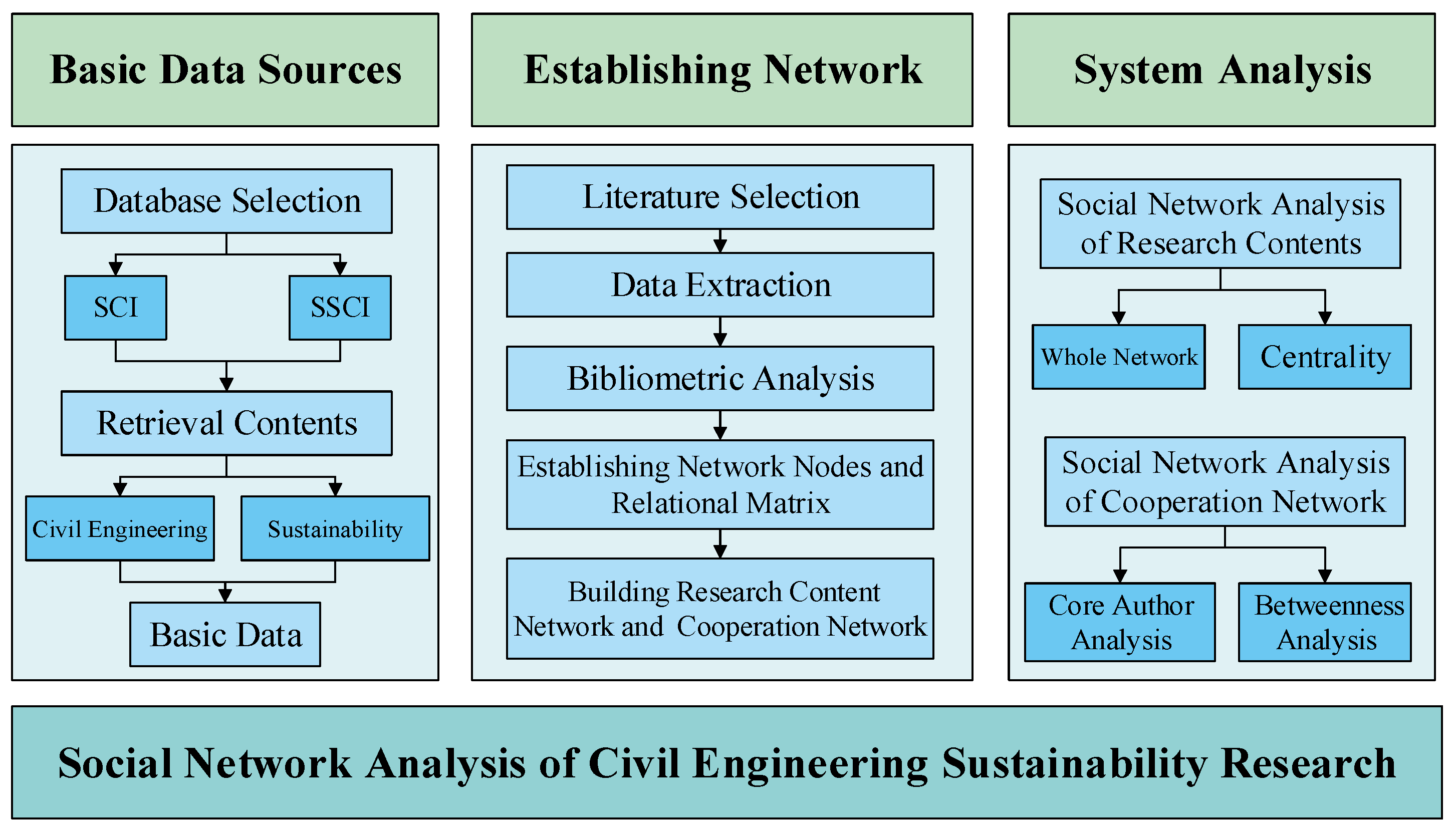


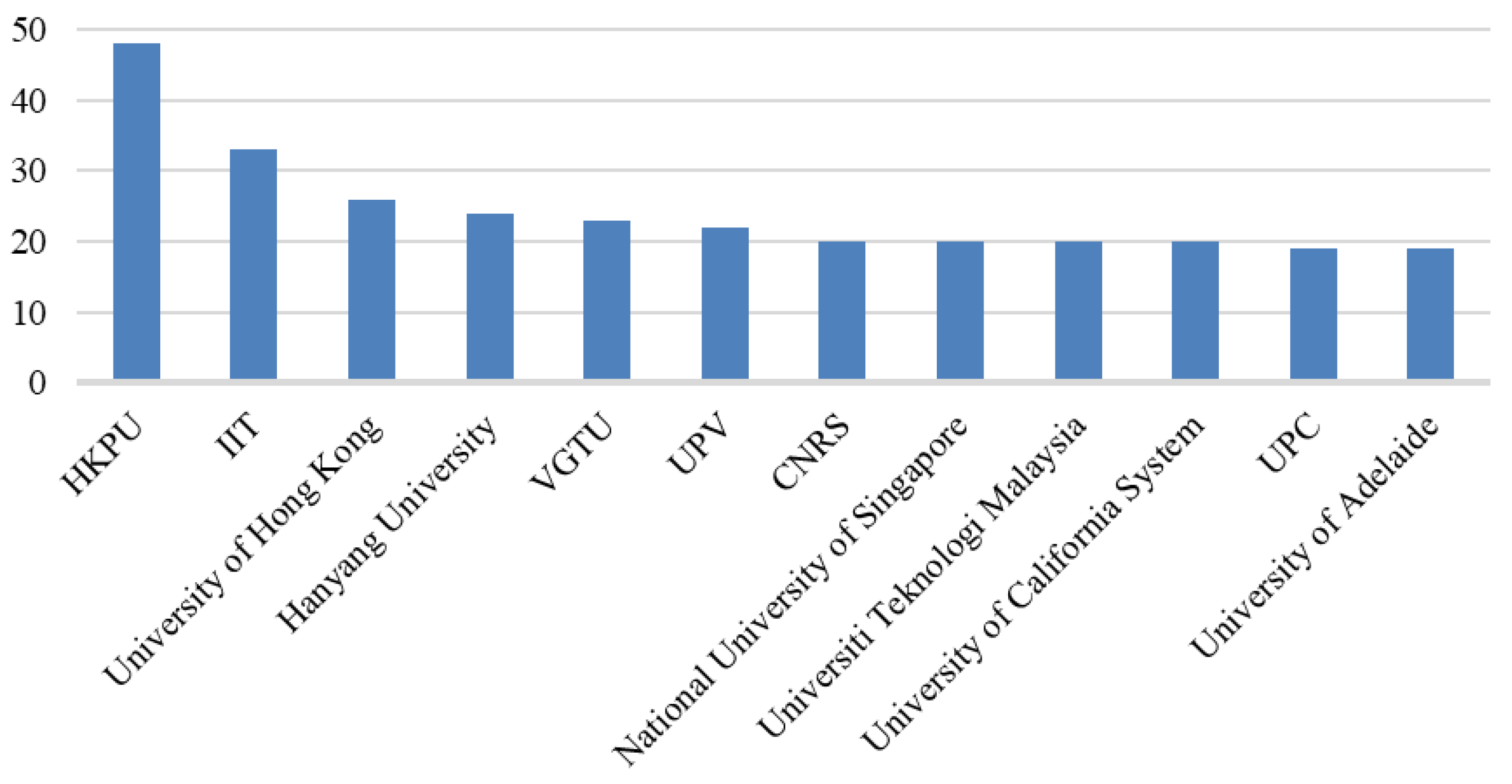
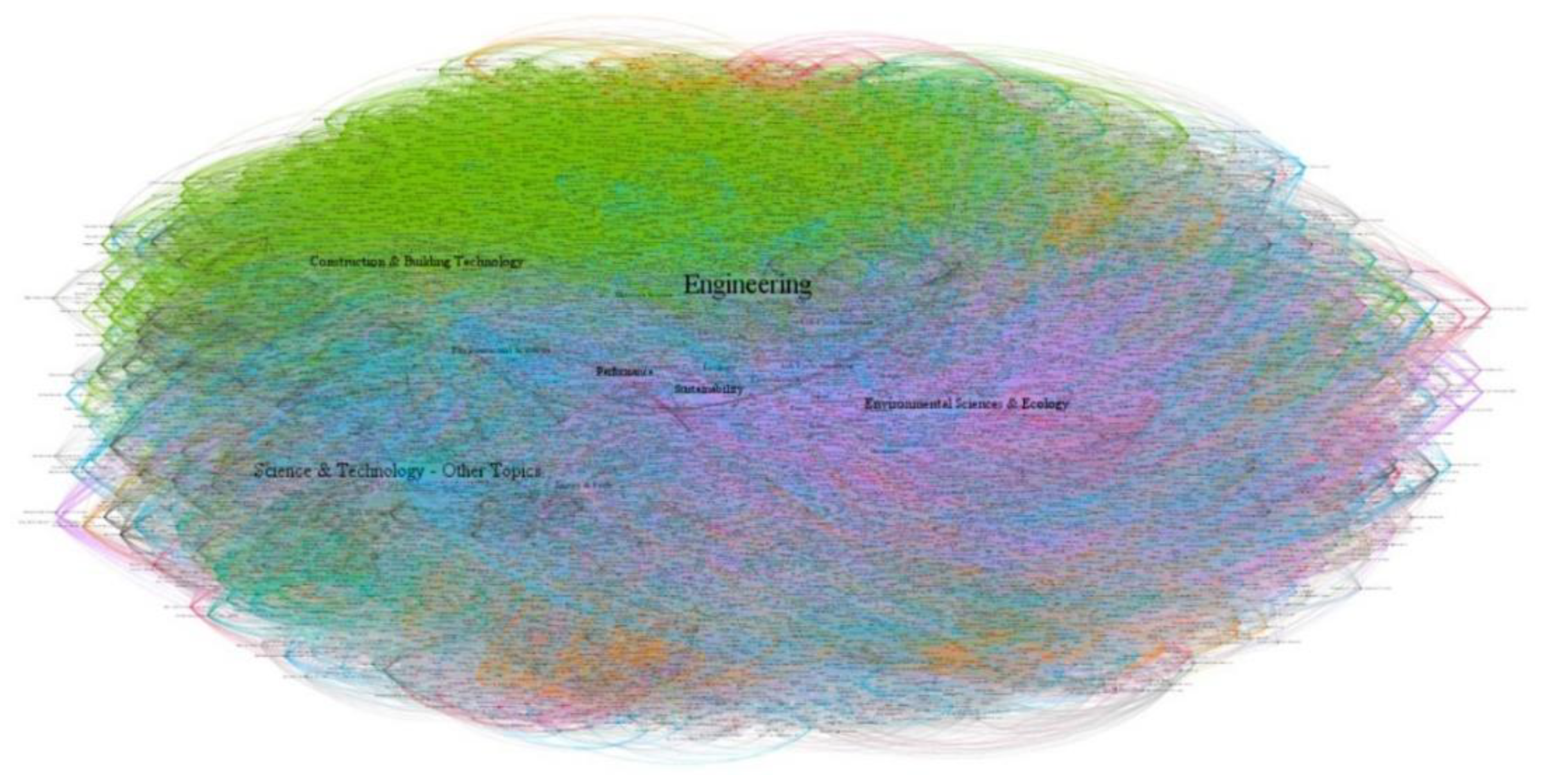

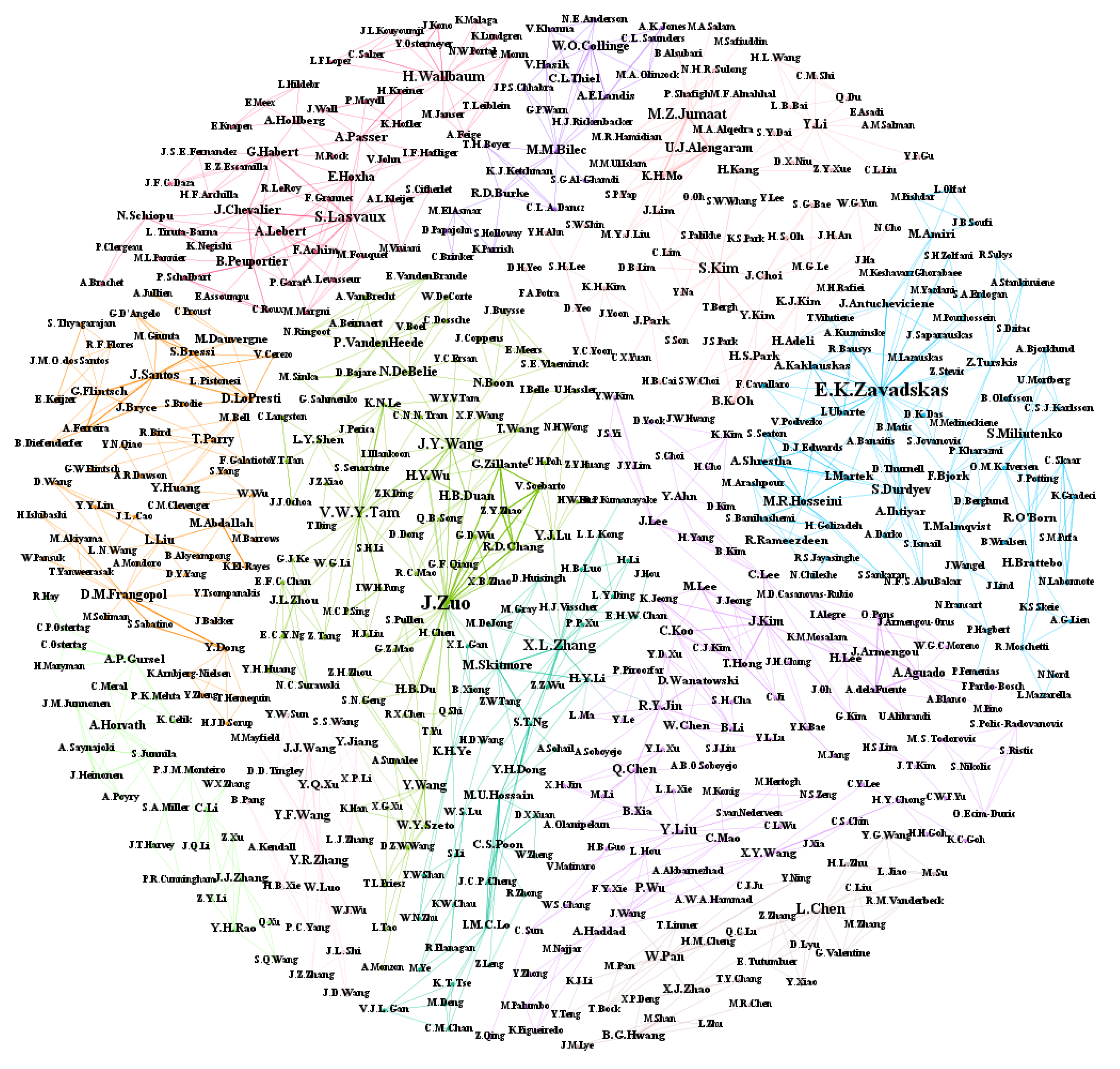
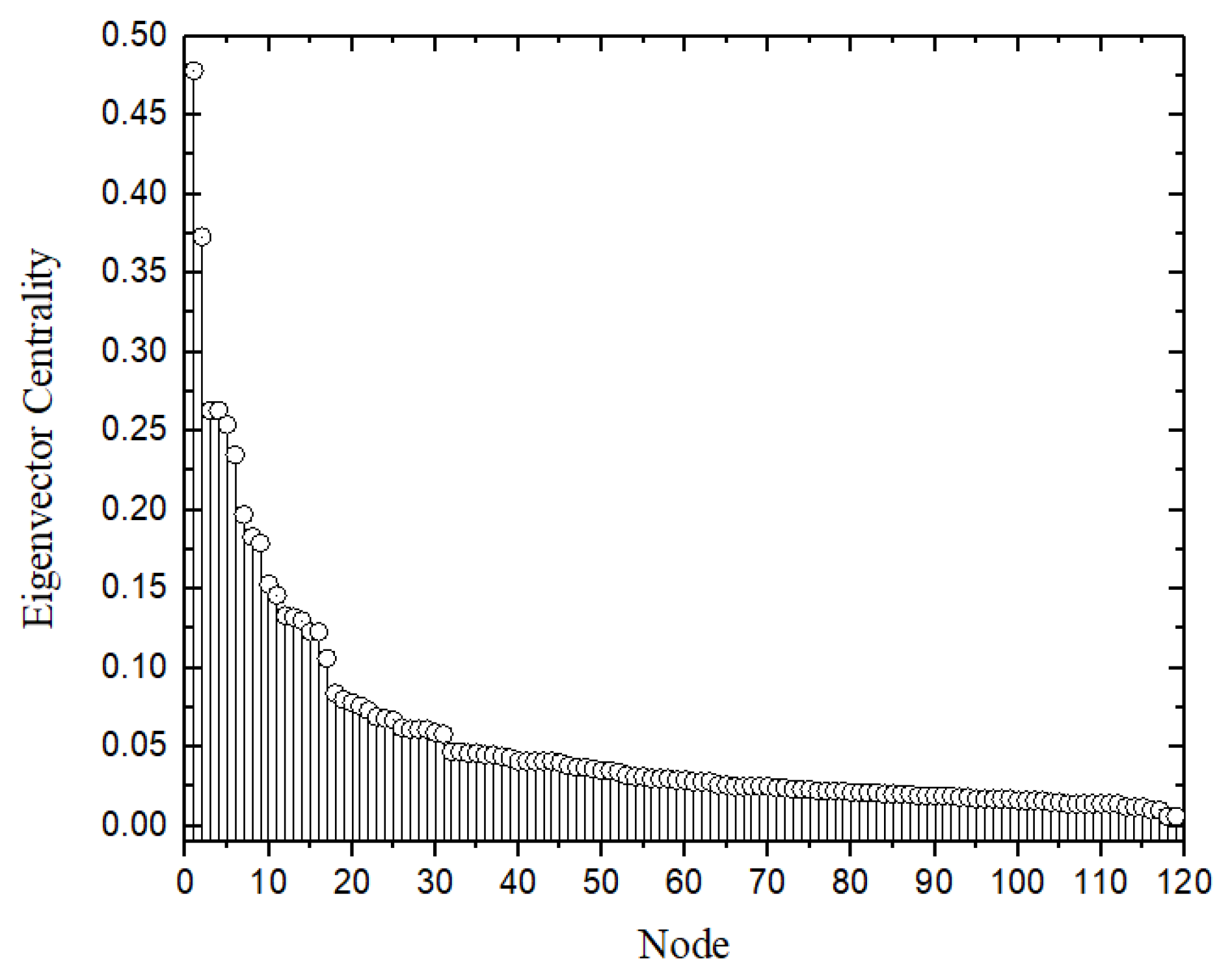
| Topics | Search Keywords |
|---|---|
| Civil Engineering | civil engineering OR building OR bridge OR road OR highway OR railway OR tunnel OR airport OR conduit OR canal OR harbor OR water & wastewater OR construction OR beam OR column OR wall OR prefabricated panel OR prefabricated slab OR concrete OR steel OR wood OR timber |
| Sustainability | sustainability OR sustainable OR life cycle assessment OR life cycle environmental OR life cycle cost OR social life cycle assessment OR life cycle sustainability OR life cycle impact OR LCA OR E-LCA OR S-LCA OR LCC OR life-cycle |
| No. | Journal | No. of Articles | Percent | IF 2019 |
|---|---|---|---|---|
| 1 | Journal of Cleaner Production | 268 | 14.52% | 7.246 |
| 2 | Sustainability | 196 | 10.62% | 2.576 |
| 3 | Energy and Buildings | 96 | 5.20% | 4.867 |
| 4 | Construction and Building Materials | 84 | 4.55% | 4.419 |
| 5 | Building and Environment | 67 | 3.63% | 4.971 |
| 6 | Sustainable Cities and Society | 63 | 3.41% | 5.268 |
| 7 | Renewable and Sustainable Energy Reviews | 46 | 2.49% | 12.11 |
| 8 | International Journal of Life Cycle Assessment | 45 | 2.44% | 4.307 |
| 9 | Resources Conservation and Recycling | 34 | 1.84% | 8.086 |
| 10 | Journal of Building Engineering | 33 | 1.79% | 3.379 |
| 11 | Structure and Infrastructure Engineering | 32 | 1.73% | 2.62 |
| 12 | Energies | 21 | 1.14% | 2.702 |
| 13 | Applied Energy | 18 | 0.98% | 8.848 |
| 14 | Proceedings of the Institution of Civil Engineers-Engineering Sustainability | 17 | 0.92% | 1.063 |
| 15 | Journal of Construction Engineering and Management | 16 | 0.87% | 2.347 |
| No. | Keyword | EC | No. | Keyword | EC |
|---|---|---|---|---|---|
| 1 | Engineering | 0.478 | 16 | Life-Cycle Assessment | 0.123 |
| 2 | Science & Technology—Other Topics | 0.373 | 17 | Materials Science | 0.106 |
| 3 | Environmental Sciences | 0.263 | 18 | Durability | 0.084 |
| 4 | Ecology | 0.263 | 19 | Buildings | 0.08 |
| 5 | Construction & Building Technology | 0.254 | 20 | Management | 0.078 |
| 6 | Sustainability | 0.235 | 21 | Impact | 0.076 |
| 7 | Performance | 0.197 | 22 | Optimization | 0.073 |
| 8 | Environmental Sciences & Ecology | 0.183 | 23 | Systems | 0.069 |
| 9 | Construction | 0.179 | 24 | System | 0.068 |
| 10 | Energy | 0.153 | 25 | Model | 0.067 |
| 11 | Life Cycle Assessment | 0.146 | 26 | Emissions | 0.062 |
| 12 | LCA | 0.133 | 27 | Mechanical-Properties | 0.061 |
| 13 | Energy & Fuels | 0.132 | 28 | Framework | 0.061 |
| 14 | Concrete | 0.13 | 29 | Strength | 0.061 |
| 15 | Design | 0.123 | 30 | Embodied Energy | 0.059 |
| No. | Author | DG | Institution | No. | Author | DG | Institution |
|---|---|---|---|---|---|---|---|
| 1 | J.Zuo | 48 | University of Adelaide | 5 | J.Kim | 25 | Sungkyunkwan University |
| 2 | E.K.Zavadskas | 38 | VGTU | 5 | M.Z.Jumaat | 25 | Universiti Malaya |
| 3 | V.W.Y.Tam | 27 | Western Sydney University | 8 | R.D.Chang | 23 | Bond University |
| 4 | S.Lasvaux | 26 | University of Applied Sciences & Arts Western Switzerland | 9 | X.L.Zhang | 22 | City University of Hong Kong |
| 5 | J.Santos | 25 | University of Twente | 10 | Y.F.Wang | 21 | Beijing Jiaotong University |
| No.B | No.D | Author | BC | No.B | No.D | Author | BC |
|---|---|---|---|---|---|---|---|
| 1 | 24 | R.Y.Jin | 24,454 | 11 | 39 | W.Pan | 7876 |
| 2 | 1 | J.Zuo | 21,783 | 12 | 59 | Y.Wang | 7763 |
| 3 | 62 | H.Y.Li | 20,349 | 13 | 2 | E.K.Zavadskas | 6722 |
| 4 | 22 | M.Skitmore | 17,963 | 14 | 134 | W.Y.Szeto | 6288 |
| 5 | 47 | Q.Chen | 14,768 | 15 | 3 | V.W.Y.Tam | 6240 |
| 6 | 33 | Y.Liu | 13,995 | 16 | 13 | J.Y.Wang | 5819 |
| 7 | 52 | C.Koo | 11,985 | 17 | 124 | Y.Jiang | 5565 |
| 8 | 121 | C.Mao | 11,613 | 18 | 9 | X.L.Zhang | 5511 |
| 9 | 6 | J.Kim | 10,891 | 19 | 16 | S.Kim | 5445 |
| 10 | 173 | J.Wang | 7905 | 20 | 93 | H.Adeli | 5158 |
© 2020 by the authors. Licensee MDPI, Basel, Switzerland. This article is an open access article distributed under the terms and conditions of the Creative Commons Attribution (CC BY) license (http://creativecommons.org/licenses/by/4.0/).
Share and Cite
Zhou, S.; Zhou, M.; Wang, Y.; Gao, Y.; Liu, Y.; Shi, C.; Lu, Y.; Zhou, T. Bibliometric and Social Network Analysis of Civil Engineering Sustainability Research from 2015 to 2019. Sustainability 2020, 12, 6842. https://doi.org/10.3390/su12176842
Zhou S, Zhou M, Wang Y, Gao Y, Liu Y, Shi C, Lu Y, Zhou T. Bibliometric and Social Network Analysis of Civil Engineering Sustainability Research from 2015 to 2019. Sustainability. 2020; 12(17):6842. https://doi.org/10.3390/su12176842
Chicago/Turabian StyleZhou, Shuowen, Min Zhou, Yuanfeng Wang, Yuanlin Gao, Yinshan Liu, Chengcheng Shi, Yongmao Lu, and Tong Zhou. 2020. "Bibliometric and Social Network Analysis of Civil Engineering Sustainability Research from 2015 to 2019" Sustainability 12, no. 17: 6842. https://doi.org/10.3390/su12176842





